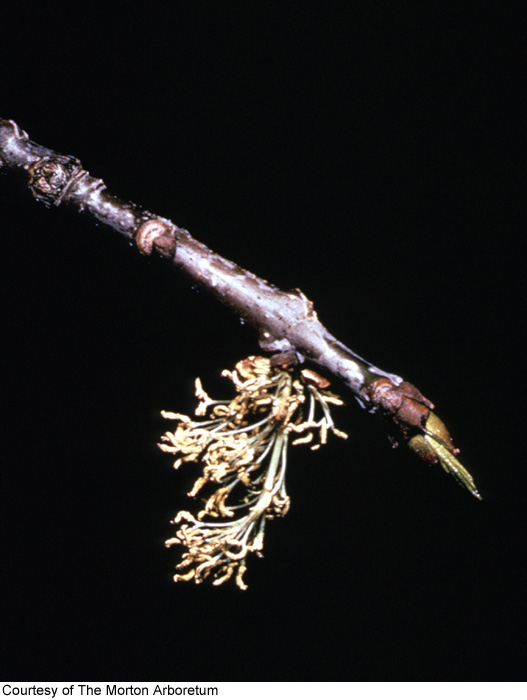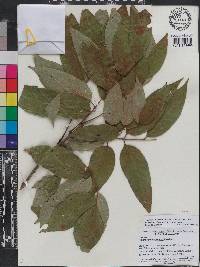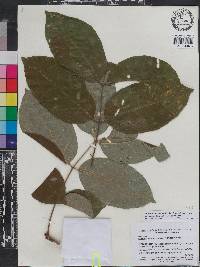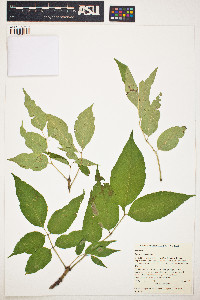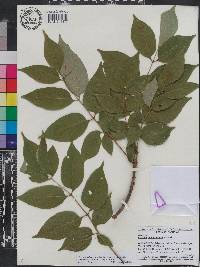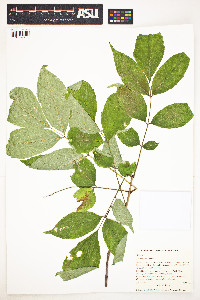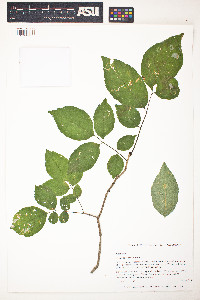- Home
- Search
- Images
- Datasets
- Sample Use
- How to Cite
- Additional Information
- About NEON
- NEON Data Portal
- ASU Biocollections
- About Symbiota
|
|
|
|
Family: Oleaceae
Texas ash, more...white ash
[Fraxinus albicans Buckley, moreFraxinus americana var. biltmoreana (Beadle) J.W.Wright ex Fernald, Fraxinus americana var. crassifolia Sarg., Fraxinus americana var. curtissii (Vasey) Sudw., Fraxinus americana var. juglandifolia (Lam.) K.Koch, Fraxinus americana var. microcarpa A.Gray, Fraxinus americana/pennsylvanica , Fraxinus biltmoreana Beadle] |
Large tree 18 - 30 m tall, trunk diameter 0.6 - 1.2 m Leaves: opposite, pinnately compound, 20 - 38 cm long, with five to nine leaflets. Leaflets short-stalked, green above, paler or whitish and sometimes hairy beneath, 7 - 13 cm long, 2.5 - 5 cm wide, egg-shaped to oblong lance-shaped with a rounded or tapering base and pointed tip, shallowly toothed, thick, and firm. Leaves turn yellow to purple in autumn. Flowers: either male or female, found on separate trees (dioecious). The loose, branched inflorescence contains tiny purplish flowers that lack petals. Calyx bell-shaped. Fruit: dry, single-seeded, winged (samara), 2.5 - 5 cm long, and narrowly cylindrical. Wing encloses the tip of the seed cavity, but it does not extend to the base. The seed cavity is relatively large compared with other <i>Fraxinus</i> species. Bark: light to dark gray, thick, deeply furrowed, with flat-topped or scaly interwoven ridges that create a diamond-shaped pattern. Twigs: thin, stout, dark green, mostly hairless, becoming gray or light brown. All but the current year's surface layer appears flaky, scaly, or peeling. Leaf scars are raised (giving the twigs a knobby appearance) with several bundle scars forming a U. Buds: dark brown, small, rounded, and finely hairy. Terminal bud 5 - 14 mm long and blunt. Uppermost pair of lateral buds adjacent to the terminal bud at nearly the same level. Form: pyramidal or egg-shaped with a straight trunk that extends well into the crown. Similar species: The other ash species of the Chicago Region look more or less similar to Fraxinus americana. Fraxinus nigra differs by having stalkless leaflets. Also, the wing of its fruit nearly extends to the base of the seed cavity. Fraxinus pennsylvanica sometimes has densely hairy shoots, and those without hairy shoots will not exhibit flaking or peeling on the twigs. The wing of its fruit encloses half or more of the seed cavity. Fraxinus profunda has conspicuously stalked leaflets, densely hairy shoots (current), and the wing of its fruit often extends to the base of the seed cavity. Fraxinus quadrangulata has square twigs, and the wing of its fruit extends to and around the base of the seed cavity. Flowering: April to mid-May, before the leaves Habitat and ecology: Dry to moist woods, valleys, and slopes. Occurence in the Chicago region: native Notes: Fraxinus americana is one of the more common forest trees in the Chicago Region. Its durable wood is used for many things, such as furniture, baseball bats, tennis rackets, oars, interior trim, and tool handles. The emerald ash borer (Agrilus planipennis) is a serious insect threat to all native ashes (see link below). Etymology: Fraxinus is the Latin word for the Ash tree. Americana means "from America." Author: The Morton Arboretum Tree to 40 m; bark becoming rather finely and closely reticulate- ridged; lfls 5-9, usually 7, oblong to ovate or obovate, usually abruptly acuminate, crenulate to sometimes entire, paler and papillose beneath; petiolules mostly wingless; twigs and lvs mostly glabrous; terminal bud generally blunt, wider than high; old lf-scars commonly with a concave upper margin; anthers linear to linear- oblong, apiculate; fr linear to oblanceolate, 3-5 cm, the wing extending a third of the length of the terete body, the free part, above the body, longer than the body itself; subtending cal 1-1.5(-2) mm, seldom cleft on one side only; 2n=46, 92, 138. A valuable timber tree of rich, moist (not wet) woods; N.S. to Minn., s. to Fla. and Tex. (F. biltmoreana, a ±pubescent, chiefly southern form, perhaps reflecting hybridization with no. 2 [Fraxinus pennsylvanica Marshall]) Gleason, Henry A. & Cronquist, Arthur J. 1991. Manual of vascular plants of northeastern United States and adjacent Canada. lxxv + 910 pp. ©The New York Botanical Garden. All rights reserved. Used by permission. |


